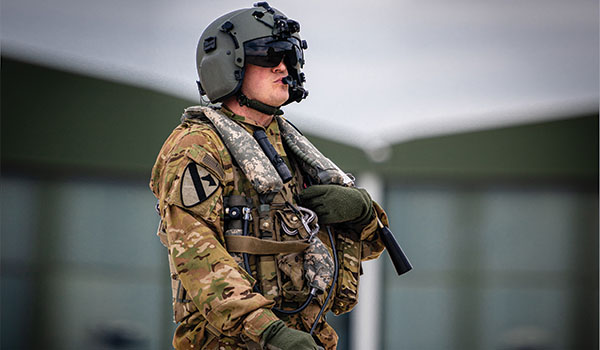
Branch Chief’s Corner / By MG David J. Francis: I will start this article by expressing my appreciation and awe at how well the Aviation branch has continued to
train and modernize the force through the current COVID crisis. Our leaders are not shying away from this fight!
Some Of What We Have Done
Over the past twelve months, our branch produced some phenomenal results for our Soldiers, our training capability, and Aviation modernization. People first – we retained 600 great Soldiers across the force. The retention of these professionals significantly enhances our ability to provide support to our fellow Soldiers on the ground. Furthermore, we saw the first increase in incentive pay in 20 years, and our Warrant Officer Bonus will continue into FY21. We also aligned our Additional Service Obligation (ADSO) with the other services.

SGT Wesley Deardurff, a CH-47 flight engineer assigned to Co. B “Big Windy,” 1-214th General Support Aviation Battalion, conducts outer pre-flight checks before an overwater training flight in the Republic of Cyprus on Jan. 15, 2020. / U.S. ARMY PHOTO BY MAJ ROBERT FELLINGHAM
We published multiple doctrinal changes to help guide how we see the enemy, fight the enemy, and how we survive while doing it. We published FM 3.04, ATP 3-04.1, ATP 3-04.2 and the Emergency Response Methodology. Additionally, the branch conducted significant experimentation using commercial off the shelf (COTS) virtual reality trainers to produce, and possibly help sustain, Army Aviators.
During this past year, the rise of Army Futures Command changed many of the ways and means by which we execute modernization, but the end state for Aviation did not change, and we continue to move the ball down the field. FARA, FLRAA, ITEP, FTUAS, and many other efforts all continued to move forward to meet milestones and received tremendous support from both the Army and Congress.
What’s Next
We are actively working to close any of the gaps we see across the Aviation Enterprise to achieve a multi-domain operations (MDO)-capable force by 2028. On the people side of the house, we are shooting to have all the funding, equipment, and maintenance lined up to significantly increase both the quality and the quantity of Army Aviators over the next few years. In addition, we continue to adapt how we train and fight against a near peer adversary to ensure we have the right organization, force structure, and equipment needed to operate dispersed over a large area and execute all the mission sets required of us in the MDO environment.
On the training side, we recently established the Aviation Warfighter
Forum – in collaboration with FORSCOM and DAMO-AV – to develop a common operating picture regarding ongoing and emergent aviation topics, with corps, division and combat aviation brigade commanders.
Where Are We Headed?
We continue to drive towards the Way point of 2028 and the Aim Point of 2035 to be MDO capable and ready with increased reach, lethality and protection. This manifests in the form of aviation formations that are optimized at echelon with our next generation manned/unmanned aircraft conducting advanced teaming with long range precision fires that are integrated into an air/ground network. The sum of each of these components will create windows of dominance that will enable expanded combined arms maneuver.
Thanks for the incredible work this year under tough circumstances. We will continue to build the Aviation Force of the Future regardless of the obstacles – because Winning Matters!
Above the Best!
MG David J. Francis is the Army Aviation branch chief and commander of the U.S. Army Aviation Center of Excellence and Fort Rucker, AL.








